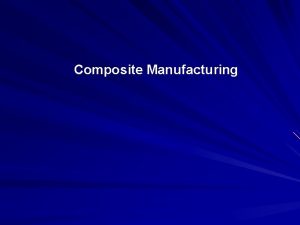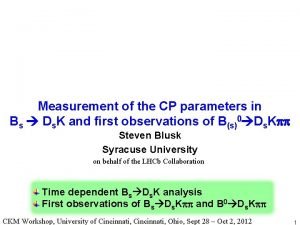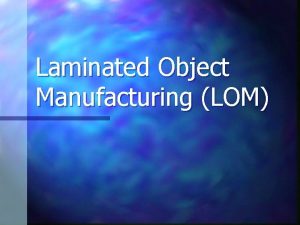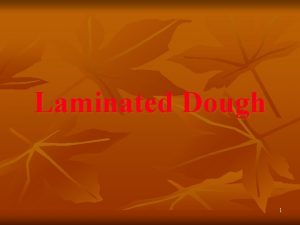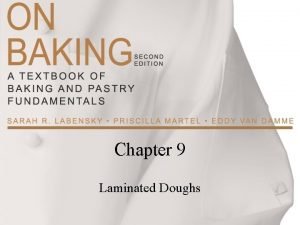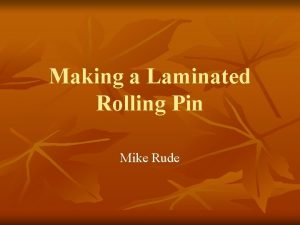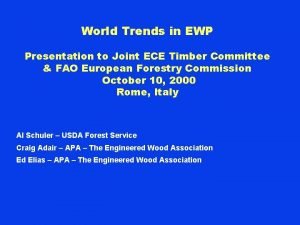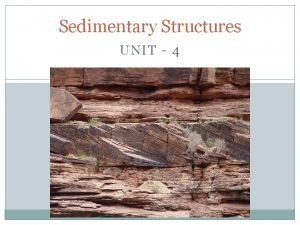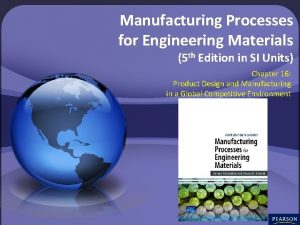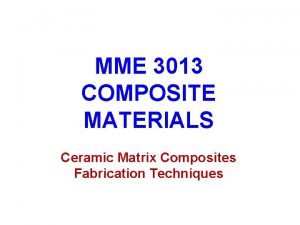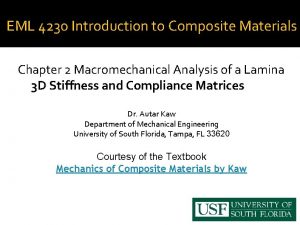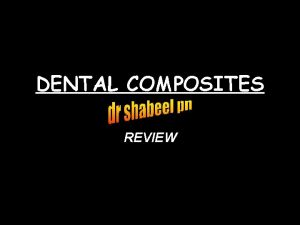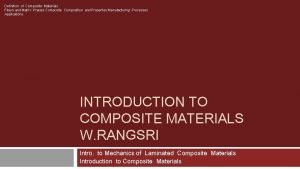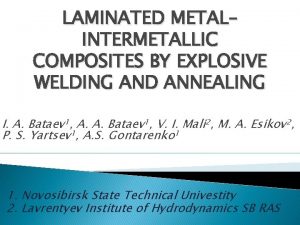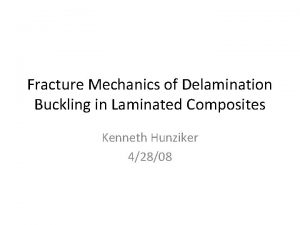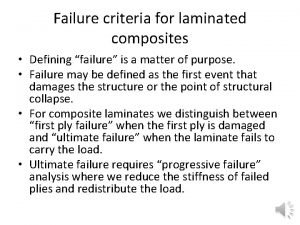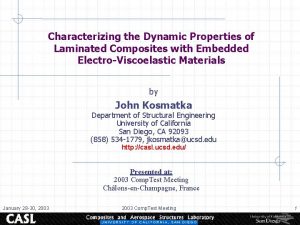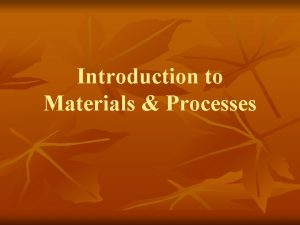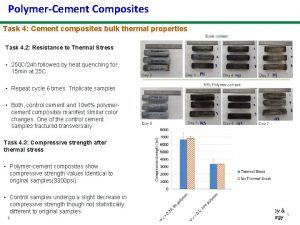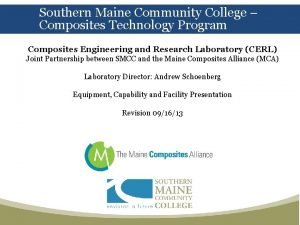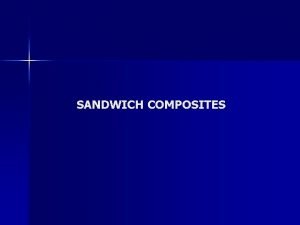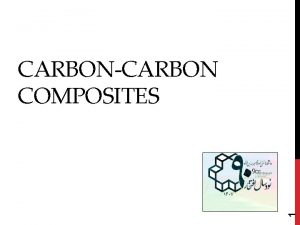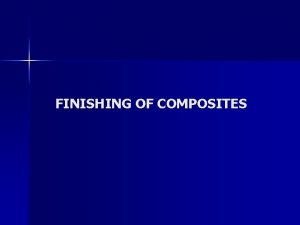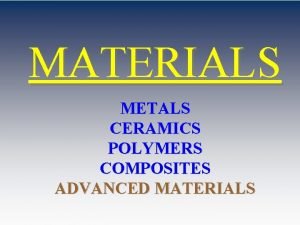MAE 661 Laminated Composites Introduction Materials and Processes
















- Slides: 16

MAE 661 Laminated Composites Introduction Materials and Processes

Fibers • Glass Fibers • Carbon Fibers • Organic fibers – Aramid, e. g. Kevlar • Others (less common) – – – Silica and quartz Carbon nanotubes Boron Ceramic (e. g. Si. C) Metals

Fiber Forms • Continuous fibers – Threads (1 -D textiles, fiber bundles) • Strand, tow, end, yarn, roving – Fabrics (2 -D textiles) • Woven as a planar cloth • Various weave patterns: plain, twill, satin • Random orientation: continuous strand mat – 3 -D textiles • 3 -D weaves, braiding, knitting • Discontinuous fibers (chopped, whiskers)

2 -D Fiber Forms

Matrix Materials • Polymer matrix (most common) – Thermoset resins: cure process involves irreversible crosslinking • Examples: – – Polyester: low cost Vinyl ester: intermediate cost/performance Epoxy: higher cost/performance Phenolic: low flammability and smoke production • Finite pot life extended by refrigeration • Cure time can be shortened by elevated temperature – Thermoplastics: no chemical change during processing • • Heated to softening temperature for processing Can be reheated/re-processed Processing is more difficult than thermosets PEEK is commonly used for high performance applications

Additional Considerations • Polymers are viscoelastic: properties are time (rate) and temperature dependent – Subject to creep and stress relaxation – Addition of reinforcements reduces viscoelastic effects – Both thermosets and thermoplastics transition from glassy to rubbery behavior at glass transition temperature (Tg) • Thermoplastics also exhibit a melt temperature Tm > Tg • Composite service temperatures generally must be below Tg • Metals and ceramics may also be used as matrix materials

Composites • Fiber reinforcements provide tensile and compressive strength (in the fiber direction) • Matrix material – – – Binds and stabilizes the fibers Provides load transfer around broken fibers Carries loads perpendicular to fiber directions Has primary influence on • Service temperature • Chemical resistance • Abrasion resistance

Sample Material Property Tables • At end of chapters 1 and 2 – Tables 1. 3, 1. 4: Properties of unidirectional composites – Tables 2. 1, 2. 2: Fiber properties – Tables 2. 9, 2. 10: Matrix properties

Manufacturing Processes • What is involved: – – Impregnation of fibers with resin Alignment of fiber directions Consolidation to remove excess resin, air, and volatile products Cure or solidification of polymer in the required shape • All processes require a mold, either open or closed, of some sort

Hand Layup • Dry fiber is placed in the mold in desired orientations • Liquid resin is poured over the fiber • Rolling compacts and removes excess resin • Room temperature or oven cured • Low-cost tooling • Labor-intensive

Vacuum Bagging/Autoclave Processing • Vacuum bagging may be used with hand layup to improve consolidation and remove volatiles during cure • Autoclaves are basically pressurized ovens – Increase pressure and improve consolidation curing cure – Used in conjuction with vacuum bagging

Prepreg Layup • The term “prepreg” is short for “pre-impregnated” reinforcement. • Prepreg is purchased with the fibers, as either unidirectional tape or bi-directional fabric, already infused with the resin • The resin is partially cured so the prepreg is tacky • Must be refrigerated during storage • May be vacuum bagged and autoclave cured • More expensive raw materials than wet layup, but cleanup is less expensive

Compression Molding • Suitable for high volume production • Most commonly used with chopped fiber prepreg or sheet molding compound (SMC) • Precise fiber orientation is not possible • Most suitable for secondary structure

Resin Transfer Molding (RTM) • • • Dry fiber is laid into bottom mold at desired orientation. Mold is closed and resin is injected to fill the mold Curing is at elevated temperature Suitable for high volume, high performance parts In Vacuum-Assisted RTM (VARTM) a vacuum is pulled on the mold during cure to remove volatiles

Pultrusion • Continuous process for producing constant cross-section parts (e. g. beams, tubes) • Suitable for high volume, high performance parts

Filament Winding • Ideal for the production of high-performance pressure vessels • Wet-winding or prepreg (towpreg) winding • More complex shapes can be produced:
 Advantages and disadvantages of thermoplastics
Advantages and disadvantages of thermoplastics 661 aess denver
661 aess denver Kpp-0-661
Kpp-0-661 Laminated object manufacturing machine
Laminated object manufacturing machine Blitz puff pastry definition
Blitz puff pastry definition Laminated dough
Laminated dough Rolling pin blanks
Rolling pin blanks Laminated veneer lumber market trends
Laminated veneer lumber market trends Transfrmers 3
Transfrmers 3 Graded bedding
Graded bedding Concurrent processes are processes that
Concurrent processes are processes that Composites and components ofsted
Composites and components ofsted Manufacturing processes for engineering materials
Manufacturing processes for engineering materials Ceramic matrix composites definition
Ceramic matrix composites definition Orthotropic stiffness matrix
Orthotropic stiffness matrix Definition of composite in dentistry
Definition of composite in dentistry Matrix phase meaning
Matrix phase meaning
